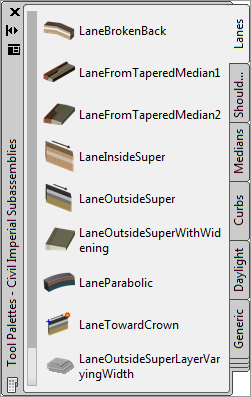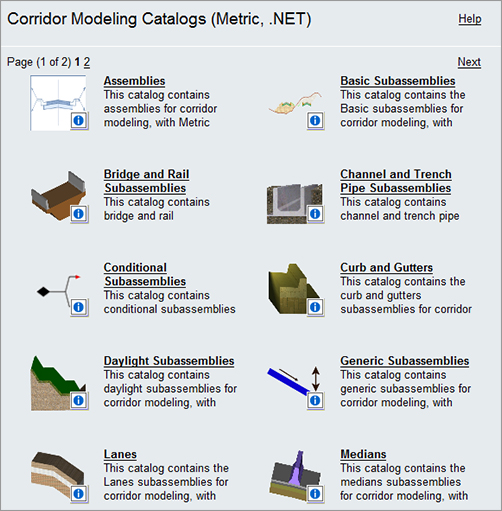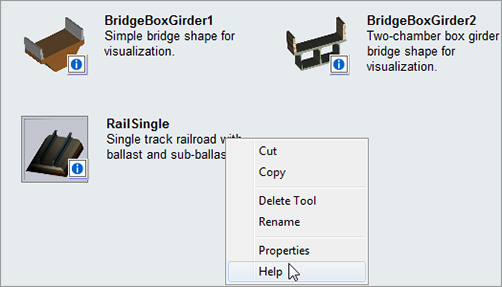A subassembly is a building block of a typical section, known as an assembly. Examples of subassemblies include lanes, curbs, sidewalks, channels, trenches, daylighting, and any other component required to complete a typical corridor section.
An extensive catalog of subassemblies has been created for use in Civil 3D. More than 100 subassemblies are available in the standard catalogs, and each subassembly has a list of adjustable parameters. There are also about a dozen generic links you can use to further refine your most complex assembly needs. From ponds and berms to swales and roads, the design possibilities are almost infinite.
You will add subassemblies to a design by clicking on them from the subassembly tool palette, as you’ll see later in this chapter. By default, Civil 3D has several tool palettes created for corridor modeling.
You can access these tool palettes by changing to the Home tab and clicking the Tool Palettes button on the Palettes panel. When Civil 3D is installed, you have an initial set of the most commonly used assemblies and subassemblies ready to go, as shown in Figure 8-1. However, there are more subassemblies available to you in the Corridor Modeling Catalog.
Figure 8-1: The Civil 3D subassemblies tool palette

Getting to the Tool Palettes
The exercises in this chapter depend heavily on the use of the Tool Palette feature of AutoCAD when pulling together assemblies from subassemblies. To avoid some redundancy, we will omit the initial step of opening the tool palette in every single exercise. If it’s open, leave it open; if it’s closed, open it. In case you need a reminder, the easiest way to open the Tool Palette feature is Ctrl+3.
The Corridor Modeling Catalog
If the default set of subassemblies is not adequate for your design situation, check the Corridor Modeling Catalog for one that will work.
Accessing the Corridor Modeling Catalog
The Corridor Modeling Catalog is installed by default on your local hard drive. Change to the Modify tab and then choose Assembly from the Design panel to open the Assembly contextual tab.
On the Assembly contextual tab, click the Catalog button on the Launch Pad panel to open a content browser interface. Choose either the Metric or Imperial catalog to explore the entire collection of subassemblies available in each category (see Figure 8-2).
Figure 8-2: The front page of the Corridor Modeling Catalog

Accessing Subassembly Help
Later, this chapter will point out other shortcuts to access the extensive subassembly documentation. You can get quick access to information by right-clicking any subassembly entry on the Corridor Modeling Catalog page and selecting the Help option (see Figure 8-3).
Figure 8-3: Accessing the Help file through the Corridor Modeling Catalog

The Subassembly Reference in the Help file provides a detailed breakdown of each subassembly, examples for its use, its parameters, a coding diagram, and more. While you’re searching the catalog for the right parts to use, you’ll find the Subassembly Reference infinitely useful.
Adding Subassemblies to a Tool Palette
If you’d like to add additional subassemblies to your tool palettes, you can use the i-drop to grab subassemblies from the catalog and drop them onto a tool palette. To use the i-drop, click the small blue i next to any subassembly, and continue to hold down your left mouse button until you’re over the desired tool palette. Release the button, and your subassembly should appear on the tool palette (see Figure 8-4).
Figure 8-4: Using the i-drop to add a subassembly to a tool palette

